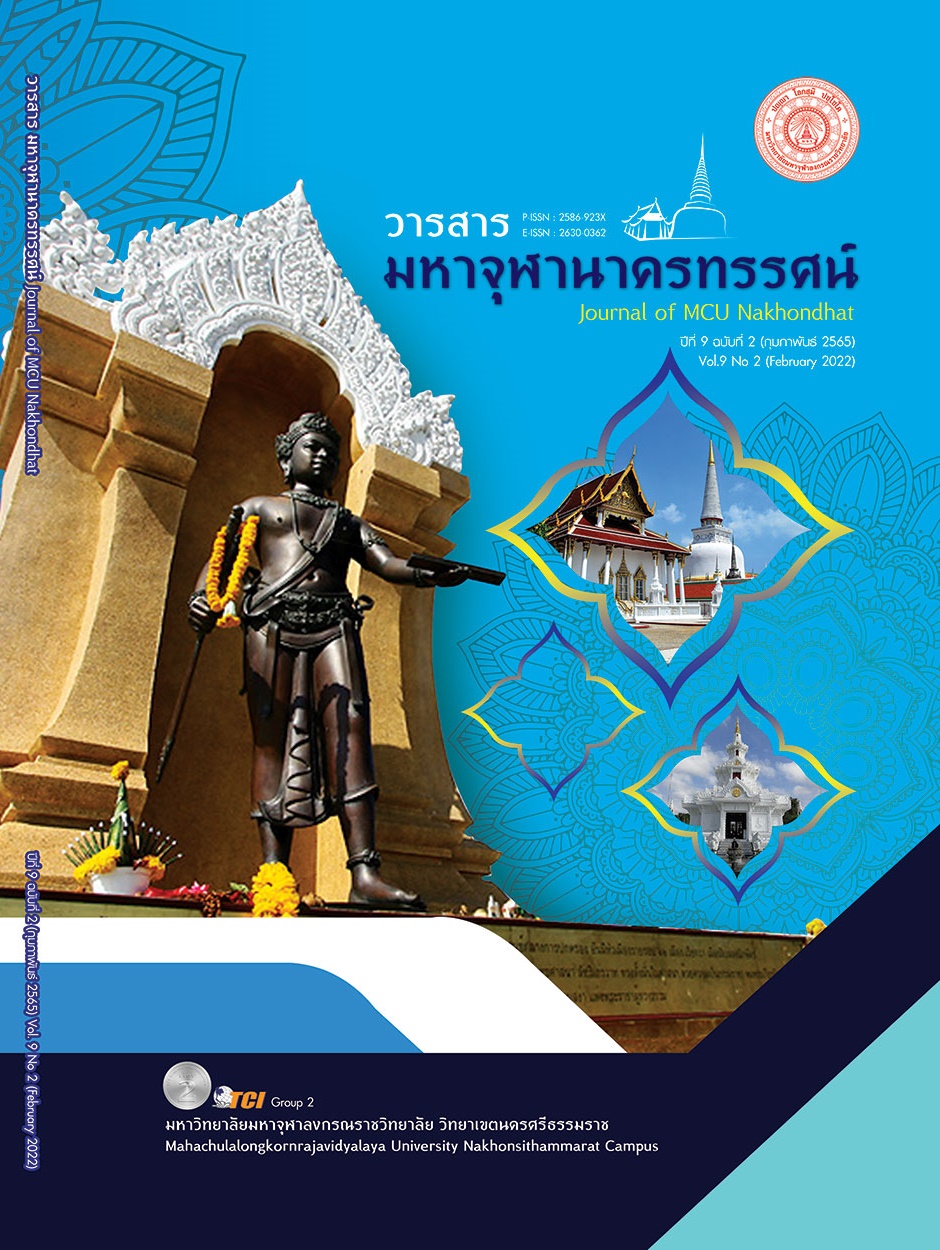POTENTIAL DEVELOPMENT OF VALUE CHAIN OF EDIBLE FERN COMMUNITY ENTERPRISE, BAN SEMA, NAKHON SI THAMMARAT
Main Article Content
Abstract
The objectives of this research were to: 1) investigate potential development of value chain of edible fern community enterprise, Ban Sema, Nakhon Si Thammarat and 2) suggest potential development of value chain of edible fern community enterprise, Ban Sema, Nakhon Si Thammarat using a qualitative research approach. The population in the study was 22 members of community enterprise, Ban Sema, Nakhon Si Thammarat. They were selected purposively and the data collected through group discussion from the samples were 8 members. All questions for group discussion were related to general information of edible fern community enterprise, Ban Sema and activities relevant to value chain. The data collected via taking note, video recording and observing the members’ participation. The data obtained were analyze by using content analysis. The results revealed that the members support themselves. Most of the customers were middlemen who loaded the products using their own cars. The members did not have their own packaging. They neither had online platform nor product warranty. The members set the price themselves. They had their own responsibilities and the money was paid to all members equally. They used mobile phones and some applications to contact both customers and members. The guideline to develop potential value chain is to use online platforms and design their own packaging for Edible Fern. Also, communication technology should be adapted to increase a number of customers. Also, Bio-Fermented water should be sprayed to edible ferns twice a month. In order to reduce cost, the members should use baskets instead of using big plastic bags. Moreover, the members should have good system to spread edible fern to middlemen. They also should manage queues for retail customers and new customers in other provinces systematically. In addition, they should spare some budget for designing packaging for their product. Furthermore, their team working should be totally reorganized. Lastly, they should design and print a guidebook for all team members to follow and run the business that is edible fern in the same pattern.
Article Details

This work is licensed under a Creative Commons Attribution-NonCommercial-NoDerivatives 4.0 International License.
References
กชนิภา วานิชกิตติกูล และคณะ. (2561). ห่วงโซ่คุณค่าเพื่อสร้างความเข้มแข็งของกลุ่มผู้ผลิตข้าวกล้องในจังหวัดมหาสารคาม. รมยสาร, 16(ฉบับพิเศษ), 184-199.
จันจิรา ศักดิ์ศรี และสปัญธ์หยก วีรบุญ์กฤช. (2564). ห่วงโซ่คุณค่าและแนวทางการพัฒนาทุเรียนหลงลับแลอุตรดิตถ์ ที่ได้รับการรับรองสิ่งบ่งชี้ทางภูมิศาสตร์. วารสารวิทยาการจัดการมหาวิทยาลัยราชภัฏพิบูลสงคราม, 3(2), 40-60.
เจษฎา นกน้อย และสัญชัย ลั้งแท้กุล. (2558). การวิเคราะห์ห่วงโซ่คุณค่าของสินค้าหนึ่งตำบลหนึ่งผลิตภัณฑ์ระดับ 5 ดาว ประเภทอาหารในจังหวัดนครศรีธรรมราช. วารสารปัญญาภิวัฒน์, 7(1), 54-66.
ชมพูนุท และคณะ. (2564). การพัฒนาห่วงโซ่คุณค่าวิสาหกิจชุมชนทำขนมต้นแบบ (ทองม้วน-ทองพับ) จังหวัดยะลา. วารสารมหาวิทยาลัยคริสเตียน, 27(1), 24-40.
ณัฐนิชา ประสาทเขตวิทย์ และคณะ. (2562). ปัจจัยที่มีผลต่อความต่อเนื่องของวิสาหกิจชุมชนในตำบลห้วยสัก อำเภอเมือง จังหวัดเชียงราย. วารสารแก่นเกษตร, 47(ฉบับพิเศษ 1), 442-446.
ดวงนภา ลาภใหญ่ และพัตรา คำสีหา. (2563). ห่วงโซ่คุณค่าและแนวทางการเพิ่มมูลค่ากล้วยไข่กำแพงเพชร สำหรับกลุ่มผู้ประกอบการในตลาดมอกล้วยไข่. วารสารมหาวิทยาลัยพายัพ, 30(1), 94-109.
นที เทพโภชน์ และวิชิต อู่อ้น. (2564). รูปแบบการจัดการห่วงโซ่คุณค่าหลังการเก็บเกี่ยวข้าวโพดเลี้ยงสัตว์ในเขตพื้นที่ภาคเหนือของประเทศไทย. วารสารสังคมศาสตร์และมานุษยวิทยาเชิงพุทธ, 6(9), 294-309.
ผู้ให้ข้อมูลคนที่ 1. (22 สิงหาคม 2564). การวางแผนจัดหาปัจจัยการผลิต. (เอื้องฟ้า เขากลม, ผู้สัมภาษณ์)
ผู้ให้ข้อมูลคนที่ 2. (22 สิงหาคม 2564). กิจกรรมสนับสนุนห่วงโซ่คุณค่าของวิสาหกิจชุมชนผักกูดบ้านเสมา. (มนทิรา สังข์ทอง, ผู้สัมภาษณ์)
ผู้ให้ข้อมูลคนที่ 3. (22 สิงหาคม 2564). กิจกรรมสนับสนุนห่วงโซ่คุณค่าของวิสาหกิจชุมชนผักกูดบ้านเสมา. (มนทิรา สังข์ทอง, ผู้สัมภาษณ์)
ผู้ให้ข้อมูลคนที่ 4. (22 สิงหาคม 2564). การกระจายสินค้า. (เมธาวัตร ภูธรภักดี, ผู้สัมภาษณ์)
ผู้ให้ข้อมูลคนที่ 5. (22 สิงหาคม 2564). การดำเนินงานของวิสาหกิจชุมชนผักกูดบ้านเสมา. (มนทิรา สังข์ทอง, ผู้สัมภาษณ์)
ผู้ให้ข้อมูลคนที่ 6. (22 สิงหาคม 2564). กิจกรรมสนับสนุนในห่วงโซ่คุณค่าของวิสาหกิจชุมชนผักกูดบ้านเสมา. (มนทิรา สังข์ทอง, ผู้สัมภาษณ์)
ผู้ให้ข้อมูลคนที่ 7. (22 สิงหาคม 2564). แนวทางการพัฒนาห่วงโซ่คุณค่าของวิสาหกิจชุมชนผักกูดบ้านเสมา. (เมธาวัตร ภูธรภักดี, ผู้สัมภาษณ์)
ผู้ให้ข้อมูลคนที่ 8. (22 สิงหาคม 2564). การให้บริการของวิสาหกิจชุมชนผักกูดบ้านเสมา. (เอื้องฟ้า เขากลม, ผู้สัมภาษณ์)
พระราชบัญญัติส่งเสริมวิสาหกิจชุมชน. (2548). ราชกิจจานุเบกษา เล่ม 122 ตอนที่ 6 ก.
พักตร์ผจง วัฒนสินธุ์ และพสุ เดชะรินทร์. (2546). การจัดการเชิงกลยุทธ์และนโยบายธุรกิจ. (พิมพ์ครั้งที่ 5). กรุงเทพมหานคร: โรงพิมพ์แห่งจุฬาลงกรณ์มหาวิทยาลัย.
พิชา วิสิทธิ์พานิช และคณะ. (2562). การศึกษาห่วงโซ่คุณค่าการผลิตและการตลาดผลิตภัณฑ์แปรรูปจากปลาเชิงพาณิชย์ในพื้นที่จังหวัดนครสวรรค์. วารสารโลจิสติกส์และซัพพลายเชน, 5(2), 89-100.
ศรีสุนันท์ ประเสริฐสังข์. (2559). การจัดการห่วงโซ่คุณค่าที่ส่งผลต่อความสำเร็จของธุรกิจหอพักในเขตเทศบาลตำบลเกาะแก้วและตำบลท่าม่วง อำเภอเสลภูมิ จังหวัดร้อยเอ็ด. วารสารวิชาการแพรวากาฬสินธุ์ มหาวิทยาลัยกาฬสินธุ์, 3(3), 41-54.
สถาบันพัฒนาองค์กรชุมชน. (2562). ตำบลท่าดี บูรณาการงานผ่านฐานทุนธรรมชาติ. เรียกใช้เมื่อ 31 ตุลาคม 2564 จาก https://web.codi.or.th/20190810-7086/


